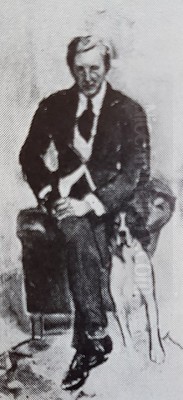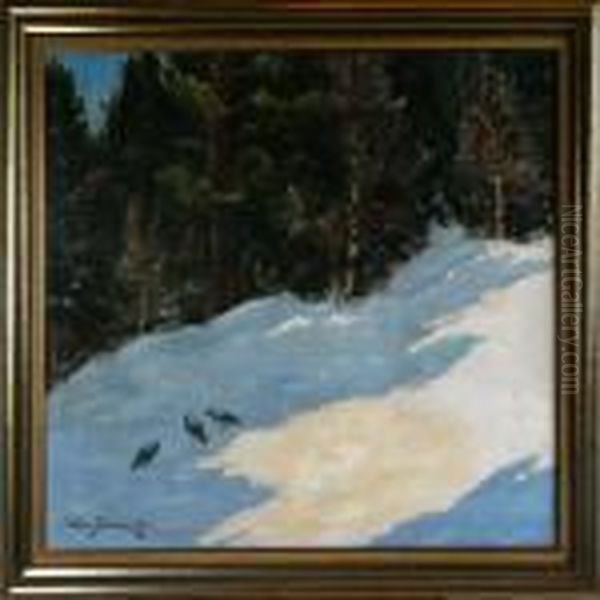
William Gislander stands as a notable figure in early 20th-century Swedish art, primarily recognized for his dedication to depicting the natural world, with a particular emphasis on avian life. Born in Sweden in 1890, Gislander developed a distinct artistic voice focused on outdoor landscapes and the creatures inhabiting them, leaving behind a body of work appreciated for its observational detail and harmonious compositions before his passing in 1937.
Origins and Artistic Beginnings
Details surrounding William Gislander's specific place of birth in Sweden in 1890 remain elusive based on available records. Similarly, the precise location of his death in Sweden in 1937 is not commonly documented. What is clear, however, is that his life spanned a dynamic period in European art, though sources do not indicate his direct participation in specific avant-garde movements or formal artistic groups that characterized the era.
His formation as an artist appears rooted in a deep appreciation for the Swedish landscape and its wildlife. Unlike many contemporaries who might have gravitated towards portraiture, historical scenes, or urban life, Gislander consistently turned his gaze outwards, finding his primary inspiration in fields, forests, coastal areas, and, most significantly, the birds that populated these environments.
Artistic Focus: Landscapes and Avian Life
The core of William Gislander's oeuvre lies in oil painting, capturing the essence of the Swedish outdoors. His works frequently feature expansive landscapes, often imbued with a sense of tranquility and natural harmony. He was particularly drawn to scenes that allowed him to integrate wildlife seamlessly into the environment, reflecting a keen eye for the interconnectedness of nature.
Birds were a recurring and defining motif in Gislander's art. He demonstrated a special skill in rendering various species, with geese and pigeons being noted subjects. His depictions were not mere anatomical studies; rather, they aimed to capture the birds in their natural element – flying across fields, gathering near water, or interacting within the landscape. This focus suggests a patient and observant approach, likely involving considerable time spent studying birds in their habitats.
Style and Technique

Gislander's style is often characterized by its use of color and composition. Sources describe his palette as employing both warm and cool tones, often saturated, contributing to a vibrant yet balanced visual experience. His compositions are noted for their harmony, suggesting a careful arrangement of elements to create a pleasing and coherent whole. He worked primarily in oils, a medium well-suited to capturing the textures and light of the natural world.
His approach emphasized realism and detailed observation, particularly evident in his portrayal of birds and landscapes. While some later commentary, referenced in historical snippets, might have critiqued aspects like color dynamism or brushwork as potentially "stiff," his overall body of work reflects a consistent dedication to representing nature faithfully and aesthetically. His paintings often convey a quiet appreciation for the scenes he depicted.
The Pivotal Mykines Visit
A significant event in Gislander's artistic life was his visit to the island of Mykines in the Faroe Islands in 1924. This journey appears to have been motivated by a desire to experience and paint the island's dramatic landscapes and, crucially, its rich birdlife. Mykines, known for its large seabird colonies, would have offered abundant subject matter for an artist with Gislander's interests.
His time on Mykines was reportedly productive, resulting in numerous works inspired by the island's unique environment. These paintings likely further honed his skills in depicting birds and coastal scenery, adding a distinct Faroese chapter to his portfolio. The experience seems to have been profoundly influential, reinforcing his commitment to nature painting.
A Catalyst for Faroese Art: Influence on S.J. Mikines
Perhaps one of the most historically noted aspects of Gislander's Mykines visit was his encounter with and subsequent influence on a young Sámal Joensen-Mikines (1906-1979). Mikines, who would later become arguably the most important painter in Faroese art history, was significantly impacted by the Swedish artist's presence and work on the island.
Sources indicate that Gislander's visit served as a crucial inspiration for Mikines, potentially providing encouragement and exposure to professional artistic practice. While the exact nature of their interaction isn't fully detailed, Gislander's focus on landscape and nature, executed with professional technique, likely resonated with the aspiring Faroese artist. This connection highlights an interesting instance of artistic exchange between Sweden and the Faroe Islands.
Representative Works
While a comprehensive catalogue might be challenging to assemble, specific examples help illustrate Gislander's output. One documented work is an oil painting from around the 1930s, measuring approximately 47 x 55 cm. It depicts a flock of geese in flight over a field, with a subtle hint of the sea in the background. This piece encapsulates his typical themes: birds in motion within a natural landscape setting.
Beyond this specific example, the body of work resulting from his 1924 visit to Mykines stands as a significant part of his legacy. These paintings, focused on the island's landscapes and bird colonies, would have showcased his skills in capturing the unique atmosphere and wildlife of that remote location.
Gislander in the Context of Swedish Art
William Gislander worked during a period when Swedish art was rich and varied. While sources confirm he wasn't tied to specific movements, his focus on nature aligns with a strong tradition in Swedish painting. He was a contemporary of, or successor to, artists who significantly shaped the national artistic identity.
For instance, Bruno Liljefors (1860-1939) was the preeminent wildlife painter in Sweden, known for his dynamic and unsentimental depictions of animals in their natural struggles. While Gislander's approach might appear calmer, the shared focus on wildlife, especially birds, places him within this lineage. Other major figures like Anders Zorn (1860-1920) and Carl Larsson (1853-1919) dominated with portraiture, genre scenes, and idyllic depictions of Swedish life, representing different facets of the era's art.
Landscape painting itself was central, with artists associated with National Romanticism like Prince Eugen (1865-1947), Karl Nordström (1855-1923), and Gustaf Fjaestad (1868-1948) capturing the specific moods and terrains of Sweden. Urban scenes found a unique interpreter in Eugène Jansson (1862-1915) with his blue-toned Stockholm vistas. Earlier figures like Ernst Josephson (1851-1906) had explored Symbolism and powerful portraiture. Gislander's work, focused purely on landscape and birds, carves out its own niche amidst these diverse trends.
Nordic Artistic Currents
Broadening the view to the wider Nordic region, Gislander's period saw significant artistic activity. Norway had Edvard Munch (1863-1944), whose expressive power took Nordic art in a new psychological direction, while painters like Harald Sohlberg (1869-1935) continued a romantic landscape tradition. In Denmark, the legacy of the Skagen Painters like P.S. Krøyer (1851-1909) celebrated light and coastal life, while Vilhelm Hammershøi (1864-1916) explored enigmatic, quiet interiors.
Finland saw the rise of figures like Akseli Gallen-Kallela (1865-1931), deeply invested in Finnish national identity through depictions of the Kalevala epic and stark landscapes. Gislander's connection to the Faroe Islands via S.J. Mikines links him to a region developing its own distinct artistic voice, one deeply tied to its unique environment and culture. While Gislander may not have shared the overt nationalistic or symbolic agendas of some Nordic contemporaries, his dedication to depicting specific natural environments aligns with a broader regional interest in landscape and identity.
Exhibitions, Collections, and Market Presence
Evidence suggests that William Gislander's work achieved a degree of recognition during and after his lifetime. His paintings were included in exhibitions, with specific mention of showings in the Faroe Islands. This indicates that his work circulated beyond Sweden and was seen as relevant within the context of Faroese art, likely due to his Mykines paintings and connection to Mikines.
His works are presumed to be held in various collections, although the provided sources do not detail specific museum acquisitions. Regarding the art market, there is little information available in the source material about the performance of Gislander's paintings at auction or their prevalence in commercial galleries. His market presence appears less documented than that of some of his more famous contemporaries.
Later Years and Legacy
William Gislander passed away in Sweden in 1937, concluding a career dedicated to the observation and portrayal of the natural world. His legacy is primarily tied to his identity as a skilled painter of landscapes and, most distinctively, birds. He captured the Swedish environment with a consistent and recognizable style.
His visit to Mykines in 1924 remains a key biographical and artistic point, not only for the works it inspired but also for its documented impact on Sámal Joensen-Mikines, adding an international dimension to his influence. Gislander represents a quieter, perhaps less revolutionary, strand of early 20th-century art, one focused on the enduring beauty and specifics of nature, rendered with care and harmonious composition.
Conclusion
William Gislander (1890-1937) was a Swedish artist who dedicated his career to capturing the nuances of the natural world, particularly landscapes and avian life. Working primarily in oils, he developed a style characterized by observational detail, harmonious composition, and a sensitive use of color. While not associated with major art movements, his work holds a place within the tradition of Swedish nature painting. His 1924 visit to Mykines in the Faroe Islands was a significant event, influencing his own work and notably inspiring the burgeoning career of the Faroese master S.J. Mikines. Though perhaps overshadowed by more famous contemporaries, Gislander's focused and aesthetically pleasing depictions of birds and nature continue to be appreciated.